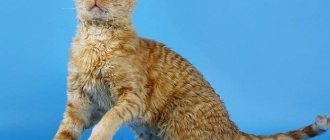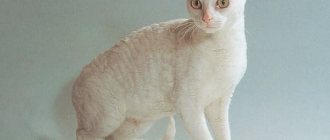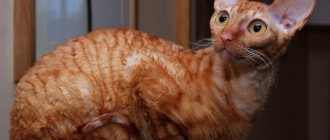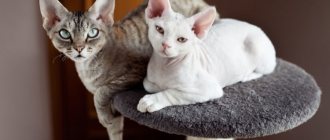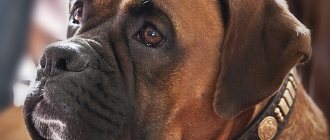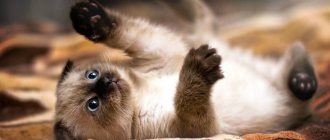What does a German Rex look like?
These are well-built cats with a proportional body, strong, large and well-developed limbs, a medium-length cone-shaped tail and a tucked belly. Wool comes in different colors, but is not monochromatic. Its density varies from a thin soft cover to a uniform dense structure, the hairs are easily curled by nature.
Muzzle
As you can see in the photo, the German Rex has a voluminous rounded head, and on it there are widely spaced ears that taper upward, have rounded tips and a strong edge on the outside.
The nose is slightly flattened, which, together with the gaze of wide-open almond, blue or yellow eyes, gives the cat a special cuteness. The cheeks are distinct, the vibrissae are short and curled.
Body type
The bones are quite large, the back is strong, the chest is rounded in profile, the body is medium-sized with well-developed muscles. The legs are thin, slender, with compact and oval pads.
The forelimbs are slightly smaller than the hind limbs. The tail is covered with abundant fur and tapers towards the end.
The marriage of an elite breed is considered:
- twisted skeleton;
- ears too small;
- pointed head;
- lack of fur in certain areas;
- incorrect teeth bite.
Animals that are too large are also rejected - the German must be graceful.
Coat and color
The German's coat is short, soft to the touch, without guard hairs and has curls that can run chaotically or in clear rows. Vibrissae on the eyebrows, just like a mustache, are curly.
The varieties of the German Rex breed are quite diverse in terms of coat color: red, black, ash or completely white cats - the combination of tones can be any.
When assessing, first of all, attention is paid not to the color of the German Rex, but to the condition of the coat - strong waviness, first of all! The highest points are given to animals with the best curly hair, even if they are inferior in body type to the rest of the exhibitors.
External signs
The expressive muzzle has clearly defined and graceful contours. The head is round in shape, the ears are quite large and widely spaced. The eyes of the German Rex are round, located far away from the nose. They have well developed cheekbones and chin. The nose is straight with a clear transition to the forehead.
The German Rex is a small-sized cat. Of course, you can’t call her a dwarf, but she also doesn’t belong to the category of large ones. The average weight of an adult animal ranges from 4 to 5 kg.
The body is fleshy and muscular, but does not create a feeling of massiveness. Rex legs are of medium length. The hind legs are slightly longer than the front legs, giving the appearance of a raised croup.
The coat of the German Rex is very soft and pleasant to the touch with characteristic waves and curls. This is especially noticeable on the back of the animal.
According to the standard, any color options are allowed, which is undoubtedly a plus, since each owner will be able to choose a kitten according to their color preference.
Character of the German Rex breed
Prussian cats are very sweet and friendly, completely devoid of aggression. They are incredibly patient and kind - they will never hurt a small child and get along well with other pets.
Rexes do not choose a leader for themselves, treating all family members well. Animals love affection and attention, quickly become attached to humans, and demonstrate their devotion and love through their voices and actions. The German Rex subtly senses the mood of people and tries to adapt to them. When the owner is in a good mood, the cat is cheerful and playful, and if the owner is sad, the animal will become quiet, sit next to him or climb onto his lap for “communication.”
The Prussian Rex loves attention. He is naturally energetic, incredibly curious and smart. Loves to play with toys, carry and hide them in secluded places. Even a castrated animal remains active and mischievous until old age.
Cats radiate positivity and lift the spirits of those around them. Even when household members do not have free time to play, the cat will always find something to do to his liking.
German rexes quickly get accustomed to unfamiliar surroundings: they explore everything and always. It is unlikely that there will be a place in the apartment where the cat does not get into: packages, boxes, bags, houses, balls are the best entertainment for them.
Despite their apparent calmness and peacefulness, the Germans are very wary of guests and hide in a secluded place when they arrive. It is quite possible that as time passes, the cat will come out of hiding to sniff strangers and even get to know each other.
In general, the character of the German Rex is very tactful and obedient. They prefer a measured and calm lifestyle, so many individuals do not tolerate moving and participating in exhibitions well.
Raising German Rex
In the world of whiskers, Prussian cats enjoy the reputation of true intellectuals: it is very easy to instill in them the necessary qualities of behavior. Curly-haired animals are easy to train, go to the litter box, do not damage furniture, carpets and wallpaper, and do not mark their territory. Training should begin at an early age, as soon as a small playful kitten gets into the house.
It is necessary to immediately show who is the owner, what can and cannot be done, and follow clear rules for the rest of the animal’s life. There is no need to strictly punish the Prussian Rex - to reprimand it is enough to raise your voice a little. There is no need to hit or drag the animal by the scruff of the neck, otherwise in the eyes of the pet you will become a threat that he will want to avoid.
Curly-haired cats are good at distinguishing the tone of commands, so raising German Rexes does not cause any particular difficulties. A little patience, love and affection - and you can teach your cat standard “dog” commands: “lie down”, “sit”, “give me a paw”, “bring a toy or ball”.
Cats enjoy walks in the fresh air and easily get used to the collar. They quickly understand the purpose of the scratching post and the tray with the filler, so there will definitely be no problems with maintaining hygiene in the apartment or house.
Proper nutrition
There are 2 types of food in stores: dry and canned. All of them can be used in a cat’s daily diet. But many veterinarians advise careful use of a diet consisting entirely of dry food.
If you choose dry feeding, make sure your pet has plenty of clean water to drink.
Do not purchase food that contains flavorings or dyes: they can cause food allergies or poisoning.
Eating habits are formed at an early age, and if you have accustomed an animal to “delicacies” from the human table, then weaning it will be problematic.
Depending on the type of food, the animal must be allocated 3 containers:
- for solid natural food, shallow, stable dishes;
- for liquid – a standard tea saucer;
- for dry food - a special deep container.
Dishes should be washed regularly.
German rexes are quite picky eaters, so it is advisable to feed them with high-quality, balanced, dry food. If the food is natural, the diet must include:
- lean beef meat (raw and boiled);
- poultry fillet (chicken or turkey);
- boiled fish, cleaned of bones;
- chicken or beef offal (lung, heart, liver);
- vegetables and fruits;
- cereals (buckwheat, rice);
- fermented milk products (low-fat yoghurts, cottage cheese, kefir);
- milk should be given with caution after the pet reaches six months of age, otherwise gastrointestinal upset may occur.
Dry and wet food should have a normal shelf life and contain taurine and healthy natural additives. It is prohibited to give:
- tubular poultry and beef bones;
- sweets and baked goods;
- legumes;
- bread;
- food from the table.
Near the bowl of food there must be a container filled with clean, fresh water. In winter, natural food should be higher in calories.
We invite you to read: Persian cat: photo, history, character, health, care
German Rex Health
Germans enjoy good health and rarely suffer from genetic diseases. On average, cats live 14 years, but with quality nutrition and proper care, the lifespan can increase to 18 years.
Get your vaccinations on time, visit the veterinarian regularly, and then the health of your German Rex will not cause any concern throughout its life.
Possible diseases
German Curlies rarely have congenital problems, but it is still worth making sure the kitten is healthy by asking the nursery for a certificate. Serious pathologies are:
- Hypertrophic cardiomyopathy
– thickening of the walls of the heart ventricle, which reduces the volume of pumped blood. This leads to a disruption in the rhythm and frequency of contractions. At the initial stage, symptoms appear extremely rarely, but the disease is very insidious and can lead to death.
- Coagulopathy
– lack of vitamin K in the body, which leads to poor blood clotting: the cat can die from its rapid loss due to injury.
The German Rex is susceptible to infectious diseases and can pick up lichen, fleas, and ticks. To prevent your pet, you need to bathe it once a week with a special shampoo, and then apply parasite-repellent products to its coat. Once every 3-4 months, rexes should be given deworming tablets.
Reproductive health
If the destiny of the Prussian Rex is to please people with its unusual beauty and devotion, and not to take part in exhibitions and increase the population, then it is better to castrate it. This is allowed to be done no earlier than 8 months of age, when the animal’s reproductive organs are fully formed. The operation is performed in a veterinary clinic.
A German Rex cat's first heat appears at about 7 months of age. You should not breed her right away: it is better to wait another 5-6 months, when the reproductive system is fully formed and the animal can produce healthy offspring.
Particular attention should be paid to choosing a gentleman. He must be purebred, without genetic diseases. It is advisable to mate an inexperienced cat with an experienced male.
Preliminary preparation is also important - expectant parents need to undergo anthelmintic prophylaxis, trim their claws and bathe them in anti-flea shampoo. In order for the cat to get used to unfamiliar territory, she is brought to the cat a few days before mating with a bowl for food and water, a bed, a tray, and her favorite toys.
Typically coverage occurs within the first 24 hours. Pregnancy appears on the 14th day and lasts up to 63 days. 7 days before giving birth, the female becomes restless, she carefully licks her fur coat and looks for a place, preparing for delivery.
Kittens are left with their mother until they are 2 months old: all this time they feed on their mother’s milk, acquire immunity and basic independent living skills.
Health
There are no special health problems in cats of this breed, as they have a good immune system and an energetic character. They live for about 15 years. Also, pets do not have pathologies, but they always tend to overeat and cannot resist colds.
Their diet must be calculated and balanced, and the food itself must be given strictly according to the schedule. Since the animal’s fur does not particularly protect it from the cold, the owner must take care of comfortable clothing and maintain the optimal temperature for the cat at home.
Another ailment that may be inherent in the German Rex is a depressive state if it is not given enough attention. Also, do not forget that they are very social creatures, so they should always be included in a social environment.
Posted by Cattery Irusan German Rex (@cattery.irusan) Feb 2, 2019 at 10:12 am PST
Features of feeding and diet
German Rexes have an excellent appetite and will eat anything. The ideal solution is to feed animals natural food, adding the following products to the daily diet:
- yogurt, sour cream, low-fat cottage cheese;
- boiled and raw beef, chicken;
- sea fish without bones;
- offal;
- boiled vegetables;
- cereal porridge;
- fresh eggs.
It is not recommended to feed your omnivorous pet greens, berries and some fruits, especially sour ones. It is not recommended to give your German Rex:
- sausages, sausages;
- skin, bones;
- smoked, fried, spicy foods;
- all flour, sweets.
Since animals are prone to obesity, they need to be fed rationed. Small kittens require frequent feeding - up to 5 times a day, “teenagers” - 3 times a day, adult cats - up to 2 times.
The serving size will determine the pet's weight. The optimal rate is calculated using the formula: the weight of the animal is multiplied by 5%. So, a 4-kilogram cat should be given no more than 200 grams of food per day.
The weight of dry food should be half as much, since it is supplemented with water and swells in the stomach. A table with standards is usually printed on the packaging. Dry food is an excellent choice if you don’t have time to cook or are afraid of creating a natural menu incorrectly.
Care and maintenance
The German Rex has no undercoat in its coat, which makes everyday care much easier. Combing is not done often - once every 4-5 days. Bathe your Rex in room temperature water with cat shampoo once every 3-4 weeks. After washing, the short coat is thoroughly dried and any drafts are avoided.
The eyes are wiped with a cotton pad soaked in black tea or a special lotion, and the ears are cleaned with the same. The claws are trimmed once every two weeks with a nail clipper, and the sharp parts of the cat are sharpened themselves. To prevent damage to furniture, carpets, curtains and wallpaper, there must be a scratching post in the house!
In the care and maintenance of the German Rex, special attention should be paid to nutrition. Cats are omnivores and love to eat, which is why they are often obese. To prevent this from happening, food should be rationed, and active games and walks in the fresh air should become a favorite activity for the pet.
During molting, you need to increase the amount of vitamin B in your food, which will prevent the appearance of unsightly bald patches on the skin. It is recommended to give the animal food with grass and special means for removing hair from the stomach. Lost hairs should be combed out every day and carefully collected from pieces of furniture with a vacuum cleaner or a damp glove.
Tips for choosing a kitten
It is quite difficult to buy a German Rex in the Russian Federation. Most likely, for show-class animals you will have to turn to European breeders and pay a lot of money. Certain difficulties will arise with transporting the animal to its future owner.
The breed is very similar to the Devon Rex, but there are differences. An elongated and rounded head, wide and large ears with very soft fluff on the back, wide open and round eyes that harmonize with the color will help to distinguish a German Rex kitten from similar breeds with curly hair.
No less attention should be paid to the purity of the pedigree - for this, breeders present metrics and certificates. The animal's father and mother must be completely healthy, and the kitten must be active, cheerful, moderately well-fed, with clean eyes and ears, a beautiful wavy coat and fully vaccinated, which should be reflected in the veterinary passport.
If you are a beginner breeder, when choosing a German Rex kitten, seek help from a professional nursery specialist. He will help you choose a purebred baby and give you tips on completing the paperwork.
Historical reference
There are two versions of the origin of the German rex. According to the first, it is believed that one of the founders of the breed was the cat Munch, born in the 30s of the last century in Königsberg (East Prussia). He got his curly hair from his parents - a Russian blue cat and an Angora cat. Hence the first name - Prussian Rex.
Lemchen's offspring were also born with curly fur, and in 1967, a representative of the Vom Grung nursery acquired more kittens. Painstaking selection work began. Hermans are not recognized in all countries, but this does not prevent the breed from gaining popularity.
How much does a German Rex cost?
The rarity of cats explains their high cost. The price of a German Rex reaches 70 thousand rubles, it depends on the purity of the pedigree and class:
- pet
– animals cannot participate in exhibitions, qualify for awards, are not bred for the purpose of further sale, but are usually purchased as a pet;
- breed
– cats meet the standards of an elite breed, but do not have any special qualities in appearance to win at exhibitions; they can produce show-class kittens when crossed with an excellent male;
- show
– kittens are very expensive, their purebred parents have titles received at exhibitions; Such animals are capable of bringing good profits to their breeder.
The cost of the kitten will have to include a trip abroad and transportation of the animal itself. But all the efforts will pay off - after all, the German Rex is capable of becoming a true family friend, giving warmth and affection to the people who love him.
What is the origin of the breed?
The German Rex cat is an ancient breed that is descended from the Cornish Rex, which is significantly different in appearance. These gorgeous cats settled in Germany in 1951. According to one version, the Cornish Rex breed was crossed with a cat that was simply found on the street. The kittens that were born were curly-haired, since their parents had a common gene, which is responsible for such a mutation.
There is another option, according to which the first information about the German Rex breed appeared in 1930. At the same time, the parents of this pet were a gorgeous Turkish Angora and a luxurious blue cat.
Actions during the Second World War, naturally, suspended the development of this breed, because many representatives of these beautiful cats simply died. However, thanks to a wonderful woman who was a doctor, and found a beautiful black curly cat, the breed was saved, as she began breeding it again in the 50s.
In addition, other sources report that the German Prussian Rex was bred in Berlin, and at first these were straight-haired cats, but after the breeders decided to mate the cat with her son, curly-haired kittens appeared. Then, already in 1969, another curly-haired baby was born in Cologne, which became a continuation of the German rex family.
At the very beginning, cats of various breeds were used to create the breed, such as Devon Rex. At the same time, the Prussian Rex (German) was definitely recognized as a European shorthair in 1970, and only in 1983 it was officially identified as a German Rex cat breed. In addition, at that time there were already two types of such cats, namely, with a chic Roman nose profile and with a clear transition from the forehead to the muzzle. Over time, the second option became the norm and became more preferable for most people. These days there are large nurseries in Switzerland, Finland and Germany.
